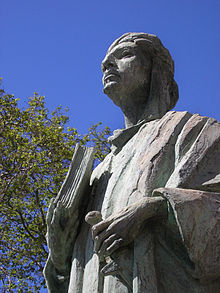
Back Almanzor AN المنصور بن أبي عامر Arabic Almanzor AST Абу Амир ал-Мансур Bulgarian Almansor Breton Almansor Catalan Almanzor Czech Almansor German Almanzoro Esperanto Almanzor Spanish
| Muḥammad ibn ʿAbdullāh ibn Abi ʿĀmir al-Maʿafiri | |
|---|---|
 | |
| Successor | Abd al-Malik al-Muzaffar |
| Born | ca. 938 Turrush, Uncertain |
| Died | August 8, 1002 (aged 64) |
| Burial | |
| House | Amirids |
| Religion | Islam |
Abu ʿĀmir Muḥammad ibn ʿAbdullāh ibn Abi ʿĀmir al-Maʿafiri (Arabic: أبو عامر محمد بن عبد الله بن أبي عامر المعافري), nicknamed al-Manṣūr (Arabic: المنصور, "the Victorious"),[1] which is often Latinized as Almanzor in Spanish, Almansor in Catalan and Almançor in Portuguese (c. 938 – 8 August 1002),[2] was a Muslim Arab Andalusi military leader and statesman. As the chancellor of the Umayyad Caliphate of Córdoba and hajib (chamberlain) for Caliph Hisham II, Almanzor was effectively ruler of Islamic Iberia.
Born in Turrush to a family of Yemeni Arab origin with some juridical ancestors, ibn Abi ʿĀmir left for Córdoba when still young to be trained as a faqīh.[3] After a few humble beginnings, he joined the court administration and soon gained the confidence of Subh, mother of the children of Caliph Al-Hakam II.[4] Thanks to her patronage and his own efficiency, he quickly expanded his role.[5]
During the caliphate of Al-Hakam II, he held several important administrative positions, including director of the mint (967), administrator for Subh and her children, administrator for intestate inheritances, and quartermaster for the army of General Ghalib ibn Abd al-Rahman (973).[6] The death of the caliph in 976 marked the beginning of the domination of the Caliphate by this functionary, which continued beyond his death with the government of two of his sons, Abd al-Malik al-Muzaffar and Abd al-Rahman Sanchuelo, up to 1009.[7] As chamberlain of the caliphate (from 978), he exercised extraordinary power in the al-Andalus state, throughout the Iberian Peninsula and in part of the Maghreb, while Caliph Hisham II was reduced to near-figurehead status.[8]
His portentous rise to power has been explained by an insatiable thirst for dominance, but historian Eduardo Manzano Moreno warns that "it must be understood within the framework of the complex internal struggles that developed within the Umayyad administration."[9] Deeply religious, he received the pragmatic support of Muslim authorities for his control of political power, though not without periodic tensions between them.[10] The basis of his power was his defense of jihad,[11] which he proclaimed in the name of the Caliph.[12] His image as a champion of Islam served to justify his assumption of governmental authority.[11]
Having monopolized political dominance in the caliphate, he carried out profound reforms in both foreign and domestic politics.[13] He made numerous victorious campaigns in both the Maghreb and Iberia.[14] On the peninsula, his bloody and very destructive incursions against the Christian kingdoms temporarily halted their advance southward.[14]
- ^ Fletcher 2000, p. 91.
- ^ Bariani 2003, p. 52.
- ^ Echevarría Arsuaga 2011, pp. 335–39.
- ^ Echevarría Arsuaga 2011, p. 42.
- ^ Echevarría Arsuaga 2011, pp. 46–48.
- ^ Cañada Juste 1992, p. 373.
- ^ Valdés Fernández 1999, p. 11.
- ^ Valdés Fernández 1999, pp. 11–12.
- ^ Manzano Moreno 2018, p. 245"Nuestro hombre no realizó su escalada hacia el poder en solitario, sino apoyado por una compleja red de relaciones familiares y políticas en las que se agrupaban algunas de las grandes familias de dignatarios que durante generaciones habían ostentado los principales cargos de la administración omeya. (…) Tan pronto como desapareció al-Halkam II, las grandes familias de la administración cordobesa decidieron resarcirse apoyando el encumbramiento de Almanzor. Su dominio puso fin a la influencia que los funcionarios eunucos y eslavos habían desarrollado hasta entonces"
- ^ Echevarría Arsuaga 2011, p. 222.
- ^ a b Valdés Fernández 1999, p. 18.
- ^ Echevarría Arsuaga 2011, p. 174.
- ^ Valdés Fernández 1999, p. 12.
- ^ a b Valdés Fernández 1999, p. 15.
© MMXXIII Rich X Search. We shall prevail. All rights reserved. Rich X Search